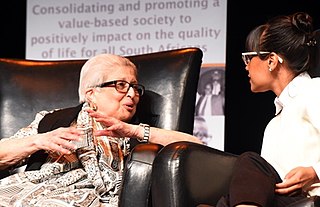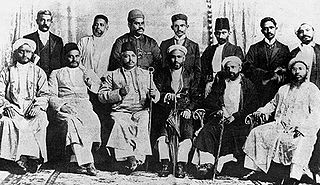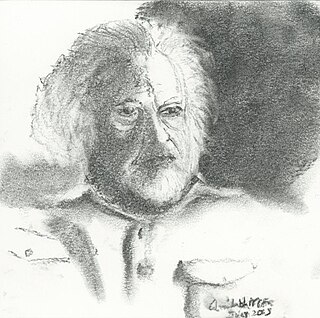Related Research Articles

Albert John Luthuli was a South African anti-apartheid activist, traditional leader, and politician who served as the President-General of the African National Congress from 1952 until his death in 1967.

The Defiance Campaign against Unjust Laws was presented by the African National Congress (ANC) at a conference held in Bloemfontein, South Africa in December 1951. The Campaign had roots in events leading up the conference. The demonstrations, taking place in 1952, were the first "large-scale, multi-racial political mobilization against apartheid laws under a common leadership."

Fatima Meer was a South African writer, academic, screenwriter, and prominent anti-apartheid activist.
The following lists events that happened during 1947 in South Africa.
Yusuf Mohamed Dadoo was a South African Communist and an anti-apartheid activist. During his life, he was chair of both the South African Indian Congress and the South African Communist Party, as well as being a major proponent of co-operation between those organisations and the African National Congress. He was a leader of the Defiance Campaign and a defendant at the Treason Trial in 1956. His last days were spent in exile in London, where he is buried at Highgate Cemetery; a few metres away from the Tomb of Karl Marx.

Frene Noshir Ginwala was a South African journalist and politician who was the first Speaker of the National Assembly of South Africa from 1994 to 2004. She was influential in the writing of the Constitution of South Africa and an important figure in establishing democracy in South Africa.

The Natal Indian Congress (NIC) was a political organisation established in 1894 to fight discrimination against Indians in the Natal Colony, and later the Natal Province, of South Africa. Founded by Mahatma Gandhi, it later served an important role in opposing apartheid. It was the oldest affiliate of the South African Indian Congress.
The Congress of the People was a gathering organised by the National Action Council, a multi-racial organisation which later became known as the Congress Alliance, and held in Kliptown on 26 June 1955 to lay out the vision of the South African people. The Freedom Charter was drawn up at the gathering, which was statement of core principles of the Alliance and a symbol of internal resistance against apartheid.
Gangathura Mohambry Naicker was a medical doctor and a South African anti-apartheid activist of Indian Tamil descent.

Indian South Africans are South Africans who descend from indentured labourers and free migrants who arrived from British India during the late 1800s and early 1900s. The majority live in and around the city of Durban, making it one of the largest ethnically Indian-populated cities outside of India.
The Transvaal Indian Congress (TIC) was a political organisation established in 1903 to fight discrimination against Indians in the Transvaal Colony, and later the Transvaal Province, of South Africa. Founded in 1903 as the Transvaal British Indian Association, it was a member of the South African Indian Congress alongside its elder and larger sibling, the Natal Indian Congress. It fell dormant after the end of apartheid in 1994.
Alpheus Hamilton Zulu was an Anglican bishop in the second half of the 20th century. Educated at the University of South Africa, he was ordained in 1940. In 1948 he co-founded with the Revd Philip Mbata, Iviyo loFakazi bakaKristu : a charismatic movement within the Anglican Church.

Moosa Moolla was an Indian South African activist and diplomat. A member of the African National Congress, Moolla was arrested and eventually found not guilty in the 1956 Treason Trial. In 1961, he was arrested and tried for incitement at the time of the May 1961 stay-at-home protest. In May 1963, he was arrested under the 90-day law. On 11 August 1963, Moolla and others escaped prison by bribing a young guard. He later served as the ANC representative to Asia while living in exile in India. Following independence, he became the first South African ambassador to Iran.
Amina Cachalia, OLB was a South African anti-Apartheid activist, women's rights activist, and politician. She was a longtime friend and ally of former President Nelson Mandela. Her late husband was political activist Yusuf Cachalia.
Ismail Ahmed Cachalia (1908-2003), popularly known as Moulvi, was a South African political activist and a leader of Transvaal Indian Congress and the African National Congress. He was one of the leaders of the Indian Passive Resistance Campaign of 1946 and the Defiance Campaign in 1952. The Government of India awarded the fourth highest Indian civilian honour of Padma Shri in 1977.

Feroza Adam was a South African political activist, a publicist for the African National Congress and other organizations. She was elected to Parliament in 1994, shortly before she died in a car accident.
The potato boycott of 1959 was a consumer boycott in Bethal, South Africa during the Apartheid era against slave-like conditions of potato labourers in Bethal, Transvaal. The boycott started in June 1959 and ended in September 1959. Prominent figures of the movement included Gert Sibande, Ruth First, Michael Scott and Henry Nxumalo.
Dorothy Nomzansi Nyembe was a South African activist and politician.
Dr. Zainab Asvat was a South African anti-apartheid activist. Asvat was trained as a medical doctor, but was politically active most of her life.
Kesval Moonsamy was a South African trade unionist, politician and anti-apartheid activist. He was one of the 156 accused in the 1956 Treason Trial. He went into exile in 1965 and returned to South Africa in 1991. Moonsamy was elected treasurer of the South African Communist Party in 1997 and served as an African National Congress Member of Parliament from 1999 until 2009.
References
- 1 2 3 4 5 6 7 "South African Indian Congress (SAIC)". South African History Online. 3 March 2011. Retrieved 2 May 2023.
- 1 2 3 4 5 Kessel, Ineke; Southall, Roger; Soudien, Crain; Soske, Jon; Shubin, Vladimir; Saul, John; Nieftagodien, Noor; Netshitenzhe, Joel; Macmillan, Hugh (2012). One Hundred Years of the ANC: Debating liberation histories today. Wits University Press. ISBN 978-1-77614-287-3.
- ↑ Bagwandeen, Dowlat (1984). "Smuts and the 'Ghetto Act' of 1946: The Coup de Grace of Anti-Indian Legislation". Journal of Natal and Zulu History. 7: 57–73.
- ↑ Desai, Ashwin (2013). "The 1946–1948 Passive Resistance Campaign in Natal, South Africa: Origins and Results". Journal of Natal and Zulu History. 31 (2): 54–67. doi:10.1080/02590123.2013.11964195. ISSN 0259-0123.
- 1 2 Vahed, Goolam (1997). "The Making of "Indianess": Indian Politics in South Africa During the 1930s and 1940s". Journal of Natal and Zulu History. 17 (1): 1–36. doi:10.1080/02590123.1997.11964094. ISSN 0259-0123.
- ↑ "The Joint Declaration of Cooperation ("Three Doctors' Pact") is signed". South African History Online. 16 March 2011. Retrieved 2023-05-02.
- 1 2 Vahed, Goolam (2013). ""Gagged and trussed rather securely by the law": The 1952 Defiance Campaign in Natal". Journal of Natal and Zulu History. 31 (2): 68–89. doi:10.1080/02590123.2013.11964196. ISSN 0259-0123.
- ↑ Vahed, Goolam; Desai, Ashwin (2014-01-02). "A case of 'strategic ethnicity'? The Natal Indian Congress in the 1970s". African Historical Review. 46 (1): 22–47. doi:10.1080/17532523.2014.911436. ISSN 1753-2523.
- ↑ "Transvaal Indian Congress (TIC)". South African History Online. 30 March 2011. Retrieved 2 May 2023.